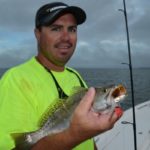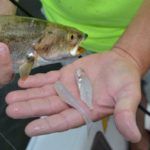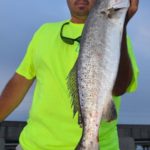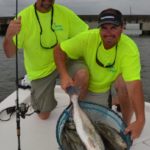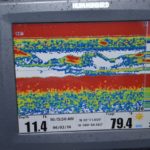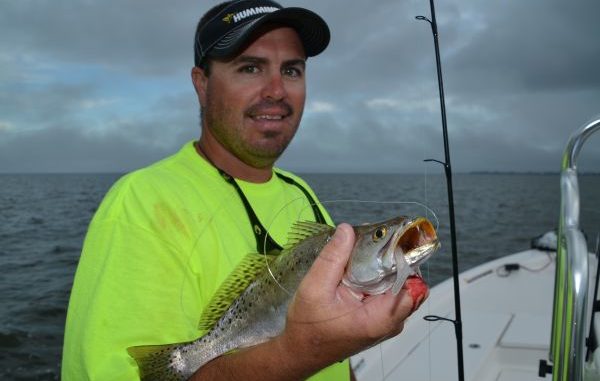
While many Lake Pontchartrain anglers are bouncing jigs and trying to discern subtle bites, this guide is fishing a rig that looks, well, stupid. And he’s putting quick limits in the boat.
“Ya wanna go fishing, Stupid?” the voice rang from up the aisle at the Louisiana Sportsman’s Show in Gonzales.
The cherubic face it came from had an innocent smile on it.
“Wa-whaaat?” I stammered in reply.
“Do you want to go stupid fishing?” asked John Falterman Jr., owner of Therapy Charters (985-649-3474) in Slidell.
“Stupid fishing or fishing Stupid,? I shot back.
“Stupid fishing,” he grinned. “I said stupid fishing both times.”
Obviously, my shotgun-induced hearing loss was worse than I thought.
“So what is this stupid fishing?” I asked, my curiosity up.
He explained that it involved a plastic cocahoe minnow hooked cock-sided on a drop-shot rig’s treble hook, and that it was deadly on speckled trout at the Lake Pontchartrain bridges.
“I’ve had customers say, ‘That’s not gonna work. That’s stupid that a fish will bite that instead of a live shrimp,’” Falterman said. “It actually does look stupid, so I call it stupid fishing.”
The appointed fishing day in June arrived ugly — heavily overcast, with a depressing drizzle. But Falterman, and his friend and fishing partner Tom Cresson were ready to go.
The two became fast friends after meeting at church a few years ago. They often fish together and, sometimes when Falterman has a charter customer, Cresson and his wife Karen will tag-along behind Falterman in their own boat.
They travel together, as well; The Cressons, and Falterman and his wife Kelle recently took a fishing vacation to Costa Rica for sailfish and tilefish.
Our destination on this morning, Falterman informed me, was going to be the St. Tammany Parish end of the Tressels, the railroad bridge that spans the eastern end of Lake Pontchartrain between Slidell and New Orleans.
This bridge and the nearby, paralleling Highway 11 bridge are well-known speckled trout hotspots.
At the bridge, I listened as the two men rigged their stupid-fishing rigs.
There was a lot of kidding, just as there would be all morning. “Go get ’em, stupid,” directed Falterman as he made his first cast.
“Let me reel in this stupid fish,” smirked Cresson after setting the hook.
Although Falterman is a level-wind reel aficionado for most of his fishing, he and Cresson used spinning reels for this tactic, a variation of drop-shot rigging.
The rig, he explained, offers a lot of wind resistance, and casting it in the wind is much easier with a spinning reel than with a casting reel.
They started catching fish immediately.
Falterman started the day off right, wrestling a speck that scaled at nearly 6 pounds into the boat right off the bat.
The hard-fighting fish was beat-up looking, with broken and torn fins and scattered sores on its body. But Felterman didn’t complain: A big trout is a big trout.
After posing it for a photo, he unceremoniously slipped it into the ice chest.
Felterman had brought a small supply of live shrimp to act as a comparison against the stupid-fishing rig. Several times during the morning, each of the anglers would hook a shrimp, but it seemed to make little difference.
Both baits caught fish.
“The fish I catch on this rig may average slightly smaller than when using live shrimp,” Falterman said, “but you can often out-catch live shrimp with a stupid-fishing rig. You don’t have to stop and go to the live well to rebait every time you lose a bait or catch a fish.
“But this type of fishing is good for lure manufacturers because the fish throw the lures off of the hooks. I can rehook a lot of them, but we may go through 40 of them on the boat in a morning.”
That’s offset by the numbers of fish brought to boat.
“As for catching a limit, this (stupid fishing) is a much faster method,” Falterman said.
The specks were greedily swallowing the plastic lures.
It was easy to see why the magneto-colored Matrix Shad was producing so well that day: Prey fish thrown up by hooked specks were match-the-hatch perfect for the lure.
Falterman also uses Matrix Shads in lemon drop and green hornet colors, as well Deadly Dudley Bay Choveys in lemon pepper and mojo mullet.
The boat was parked with the stern pointed upcurrent toward the bridge, allowing both men room to fish from the wide rear rather than the narrow bow. The action was so fast I hadn’t noticed that Falterman had neither tied the boat off nor anchored it.
Instead, the boat’s Minn Kota remote I-Pilot trolling system held it perfectly positioned, whether the wind blew or not and in varying water currents. It was amazing.
Falterman called it “the greatest thing ever.”
“It saves your back — no anchor. Movement is quicker — no anchor,” he said. “I believe in moving if the fish aren’t biting in a spot. I don’t particularly target one spot to fish. There are often long stretches of bridge with no bait or fish.”
Falterman moves the boat slowly and watches his side-imaging and down-imaging sonar for bait balls and trout.
When he spots what he wants, he drops his trolling motor and hits the spot-lock button to peg the boat in place.
Falterman explained that he seldom fishes the east side of the bridge. His preference is to fish incoming tides and fish on the downcurrent side of the bridge.
Speckled trout can be found as far as 150 yards from the bridge. How far is determined by the strength of the current. Experience and a good sonar are very helpful in finding fish positioned away from the bridge.
But there was no reason to move the boat that morning. Almost every cast seemed to produce a fish.
Some were 12 to 13-inchers. Some went 2 pounds. A few were larger, although none topped the big one Falterman caught early that morning.
The technique was simple: The men cast toward the bridge at varying distances from its pilings. After the weight hit the bottom, they would bounce the rigs off the bottom every so often, taking up a couple of turns on the reel handle each time.
Invariably they would grunt, “There it is,” and the rod would arch sharply.
It was over all too quickly. By mid-morning, the box was three-quarters full of fish, and heavy rain that had been threatening since daylight seemed nearer than ever.
The happy men left them biting.
